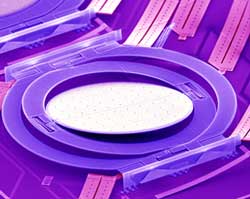MEMS
MEMS (micro-electro-mechanical systems) are tiny electo-mechanical devices made by some of the same methods as integrated circuits. The results are some of the smallest machines ever made, capable of being built on a silicon wafer alongside the circuits that control them. Most MEMS devices are still experimental, but they are already being used in cars to deploy airbags and actuate antilock brakes, in integrated optical switches to handle Internet traffic, and in many other areas.
MEMS were first proposed in the 1960s, but not commercialized until the 1980s. Engineers and scientists wanted to use integrated circuit fabrication techniques to make tiny mechanical systems, which could, if necessary, be connected to electronic circuits on the same chip. One of the first commercial applications of MEMS was the tiny nozzle assembly used in the cartridges of inkjet printers. Each of the nozzles in an inkjet printer’s printhead consists of a hollow chamber. Inside, ink flows in, is heated with tiny electric heating elements, and is then expelled through a port. The chamber and all its features are created using the same photolithography techniques as an integrated circuit.
In 1982, automotive airbag systems (which had been proposed in the 1950s) were introduced using MEMS sensors to detect a crash. The Analog Devices Corporation elaborated this idea, producing an “accelerometer” for airbag systems in 1991, where the mechanical and electronic portions were integrated on the same chip. The accelerometer chip detects the sudden increase or decrease in speed that occurs during a crash. The same company later introduced a gyroscope-on-a-chip, capable of working with an automobile’s global positioning system to create more accurate maps and directions for drivers.
